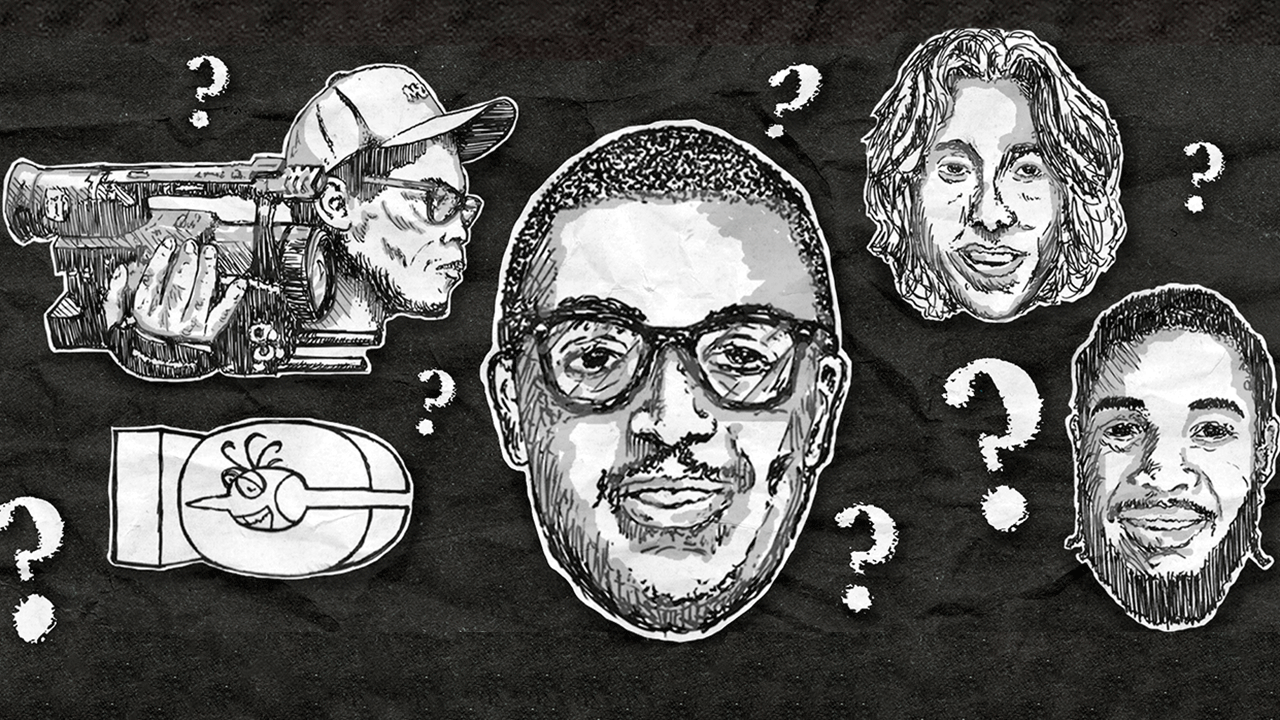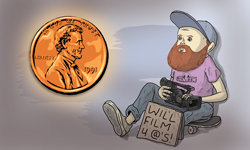
Any young person in the mid-2000s who wanted to look “like a skater” or feel tapped into the skateboarding scene, even if only superficially, probably owned a pair of white leather Etnies Callicuts. Soon after the shoe was released in 2003, it crossed over from skateboarding into normie fashion and blew up. The Callicut became the definitive skate shoe for a generation of non-skateboarders who are now preserved in the following meme:

But I never understood why this shoe, of all possible skate shoes, became the shoe for wannabe skateboarders and found so much success outside of skateboarding. So to try to figure out, I went where the archetypal Callicut fans — teenage girls from the mid-2000s — hang out today: Instagram.
@thighsandsighs remembered getting white and pink Callicuts in 2004-2005. “I went down to the mall and made my mom buy me some Etnies in hopes of becoming a cute lil’ punk skater chick,” she wrote.
Another woman, @taylormarieexx, told me she liked the Callicuts because they were the only “girly” skate shoes. “I hung out with all boy skaters so I always had Etnies, DVS, and DC, but these were one of the few that were pink,” she wrote.
“I bought them two sizes bigger and wore five pairs of ankle socks to try to fill them up.”
The most candid response was from @dumb.virgin, who told me she had “a huge surf-skate-poser aesthetic,” and wore Callicuts because their puffy size made her ankles look skinnier. “I bought them two sizes bigger and wore five pairs of ankle socks to try to fill them up.”
The only respondent who looked down on the Callicut was @goth.spice. She called the Etnies “hood rat shoe[s],” and told me she never bought them because “all the hoochies back in the early 2000s wore [them].” To her, Callicuts were shoes for girls who “dress like a skater girl to get at these skater boys.”

callicut fan from italy (2015)
I asked Don Brown, Sole Tech’s key marketing guy for the past 30 years, if Etnies had targeted this “teenage girl, wannabe skater” demographic in order to spread the shoe. Brown told me they didn’t sell the Callicut specifically as a shoe for non-skaters, but because Etnies had been making women’s shoes for years and selling their products in skate shops and mainstream stores, they had the right footing for a model like this to catch on.
“When it came to the Callicut for girls, it was more that the product was in wider distribution where girls would shop,” Brown told me over email. “When we did a white with pink ‘E’ and a white with baby blue ‘E,’ holy shit. Things went crazy. The bigger retailers like PacSun and Journey’s couldn’t keep the Callicut in stock. I feel that every teenage girl in the world had that white/pink Callicut.”
It’s easy to see why a skate shoe in the mid-2000s would become so popular with teenage girls. Those were the glory days of Bam Margera and Ryan Sheckler making skateboarders into sex symbols. But I wondered why the Callicut in particular became the go-to shoe for girls wanting to get in on that “skater style.”

The Callicut’s connection to skateboarding helped it appeal to people outside of skate culture, but I doubt these non-skateboarders would have bought into it so heavily if it didn’t also have a relatively simple, “classic” design. If you wanted to buy a skate shoe back then, all your choices were techie monstrosities. The smaller brands — DC, Emerica, Circa, Osiris, Airwalk — and larger brands — Vans, adidas, Nike SB, Converse — all made shoes that looked extremely specialized for skateboarding.
At the same time, the big footwear brands weren’t pushing their classic shoe models — Authentics, Superstars, Blazers, Chuck Taylors — as skate shoes (unlike how they do today). This left a market gap that Etnies filled. Because anyone who wasn’t a skateboarder, but wanted an inconspicuous skate shoe, was kind of out of luck until the Callicut came along.
Franck Boistel, who’s responsible for iconic skate shoes like the éS Koston 3 and Chad Muska’s first stash pocket kicks, also designed the Callicut. He told me the idea for the Callicut came from wanting to make a skateboard version of adidas’ Stan Smith. “There is no hiding that we coined this design from the Stan Smith,” he said. “Jason Smith [Sole Tech product manager] and I identified something in it that would work in the skate world and we did our twist on it.”
Other skate brands quickly caught onto the court shoe trend that the Callicut sparked. DC made their similar looking Court model, followed by Adio’s Heartagram Bams. Like the Callicut, the Court and Heartagram Bam both had pink colorways that were big hits with the teen girl demographic. But because the Callicut came first, and Etnies had already been selling their footwear in mainstream shoe stores for years, the Callicut had a broader reach outside skateboarding.

suri cruise rocking baby callicuts
Pop stars of the time — Avril Lavigne, Ashlee Simpson, the screamo band My Chemical Romance, and the One Direction kids — all wore Etnies clothes or shoes. Disney made a branded Callicut colorway and gave Callicuts to their kid actors. Etnies even made baby-sized Callicuts that celebrities copped for their children. Just knowing that Etnies made the investment to create kids’ models of a skate shoe shows how successful the Callicut became.

With all this momentum, the Callicuts developed a diehard fanbase. Years ago, Brown and Boistel told me they received letters and photos from women who wore Etnies at their weddings. Though they weren’t able to dig any of these up, I found a guy, Jeff Dolan, who had customized Callicuts made for his wedding in 2011.
Dolan, who’s now in his late 30s and does not skate, told me over email that to him, the Callicut was synonymous with skateboarding. “It was always the iconic skate shoe for me. My wife and I wanted to put our personal touch on our wedding and the shoes just made sense. I still have them, as do my best friends.”
It’s easy to fit a pair of Vans Authentics or Slip-Ons into a wedding outfit, but getting married in Callicuts is not subtle or, I would argue, particularly stylish. That kind of commitment stems from a sense of brand loyalty that goes back to before skate shoes were considered fashionable.

In the Callicut’s heyday, Brown told me Etnies was making 60,000 pairs per month in each colorway. When I asked Brown if the Callicut was especially profitable, he wrote, “Fuck yes. It enabled us to pay our skate team the highest salaries, create events…[and] support all the skate shops.” Brown also told me that when the Callicut blew up, Sole Tech was able to reinvest those profits into their more core shoe brands, éS and Emerica. “We had enormous success doing that and it would bring money to feed all the other brands we had,” Brown wrote.
So although the Callicut fed the growing demand of non-skateboarders wanting to appear to be skateboarders, or really just appear to be affiliated with skateboarding, it also helped its parent company support skate shoe brands that weren’t catering to outside audiences.
For the generation that came of age in the mid-2000s, the Callicut was the first skate shoe to experience huge crossover success. It showed skate footwear brands that making more mainstream models could really pay off, and now the norm for skate footwear brands is to make some if not most of their shoes with casual wearers in mind.
The Callicut fizzled out as skate shoes slimmed down toward the end of the 2000s, but its influence is still felt today in the regular-ass people buying skate shoes because they think they’re “cool.” I know the original Callicut isn’t a fond memory for a lot of skateboarders, but it deserves at least as many cult jokes as the ugliest skate shoe of all time.
Related Posts
Comments
Popular
-
 WHAT THE HELL IS GOING ON WITH ILLEGAL CIV?
WHAT THE HELL IS GOING ON WITH ILLEGAL CIV?
The Illegal Civ stuff feels like an ongoing soap opera, so to air out any confusion we talked to a few key characters.
-
 A SERIOUS REVIEW OF MARK SUCIU’S SERIOUS “VERSO”
A SERIOUS REVIEW OF MARK SUCIU’S SERIOUS “VERSO”
Verso asks that we pay it a kind of attention many of us automatically do not. Knowing this, we choose to either look more closely or let it pass before our eyes the way the rest of skating does.
-
 WHAT HAPPENED TO GERSHON MOSLEY?
WHAT HAPPENED TO GERSHON MOSLEY?
From punching Andrew Reynolds, to not getting "pimped" by the industry, Gershon covers everything you wanted to know.
-
 BRINGING THE TRUCK INDUSTRY TO EUROPE WITH JÉRÉMIE DACLIN
BRINGING THE TRUCK INDUSTRY TO EUROPE WITH JÉRÉMIE DACLIN
Why are there so few successful truck companies in skateboarding? We talked to Jeremie to find out.
-
 STEFAN JANOSKI IS THE MOST CURIOUS PERSON IN THE ROOM
STEFAN JANOSKI IS THE MOST CURIOUS PERSON IN THE ROOM
I followed Stefan Janoski around for five days to try to see into his mind.








November 20, 2018 5:19 pm
here we go again
November 20, 2018 6:01 pm
i had these shoes
November 20, 2018 6:02 pm
etnies ‘rap’, sand-color on gum, circa ’93 = only former legit model of said brand.
November 21, 2018 8:47 am
Mid-2000s…is it just me or this term does not mean anything anymore ? Actually, mid2000 should be around year 2500…
November 21, 2018 12:12 pm
literally correct; pedantic, si.
re. “oodles and oodles of Os u know…
…u get em from your sister, u get em from your bro”
– old Carroll-of-the-Mike part.